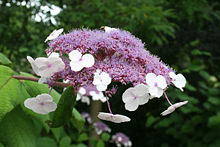
Hydrangea, commonly named the hortensia, is a genus of more than 70 species of flowering plants native to Asia and the Americas. By far the greatest species diversity is in eastern Asia, notably China, Korea, and Japan. Most are shrubs 1–3 m tall, but some are small trees, and others lianas reaching up to 30 m (100 ft) by climbing up trees. They can be either deciduous or evergreen, though the widely cultivated temperate species are all deciduous.

Anemone is a genus of flowering plants in the buttercup family Ranunculaceae. Plants of the genus are commonly called windflowers. They are native to the temperate and subtropical regions of all continents except Australia, New Zealand, Antarctica and the Middle East. The genus is closely related to several other genera including Anemonoides, Anemonastrum, Hepatica, and Pulsatilla. Some botanists include these genera within Anemone.

Carpenteria, the tree anemone or bush anemone, is a genus of flowering plants in the hydrangea family Hydrangeaceae. It is closely related to the similar genus Philadelphus and is monotypic, being represented by the single species Carpenteria californica which is a flowering evergreen shrub native to the Sierra Nevada foothills in California.

Daboecia, or St. Dabeoc's heath, is a small genus of flowering plants in the family Ericaceae, containing two evergreen shrubs, closely related to the genus Erica. They are native to cliffs and heathland in southern Atlantic Europe and the Azores.

Fremontodendron, with the common names fremontia and flannelbush or flannel bush, is a genus of three known species of shrubs native to the Southwestern United States and northwest Mexico.

Lavandula stoechas, the Spanish lavender or topped lavender (U.S.) or French lavender (U.K.), is a species of flowering plant in the family Lamiaceae, occurring natively in several Mediterranean countries, including France, Spain, Portugal, Italy, Turkey and Greece.

Hydrangea macrophylla is a species of flowering plant in the family Hydrangeaceae, native to Japan. It is a deciduous shrub growing to 2 m (7 ft) tall by 2.5 m (8 ft) broad with large heads of pink or blue flowers in summer and autumn. Common names include bigleaf hydrangea, French hydrangea, lacecap hydrangea, mophead hydrangea, and hortensia. It is widely cultivated in many parts of the world in many climates. It is not to be confused with H. aspera 'Macrophylla'.
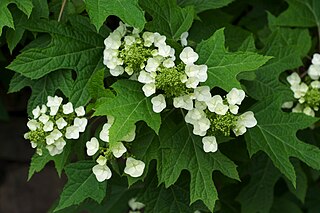
Hydrangea quercifolia, commonly known as oakleaf hydrangea or oak-leaved hydrangea, is a species of flowering plant in the family Hydrangeaceae. It is native to the southeastern United States, in woodland habitats from North Carolina west to Tennessee, and south to Florida and Louisiana. A deciduous shrub with white showy flower heads, it is grown as a garden plant, with numerous cultivars available commercially.
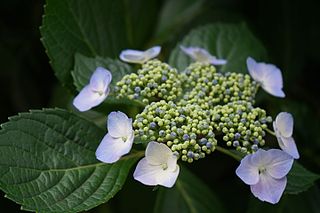
Hydrangea anomala, the Japanese climbing-hydrangea, is a species of flowering plant in the family Hydrangeaceae native to the woodlands of the Himalaya, southern and central China and northern Myanmar.
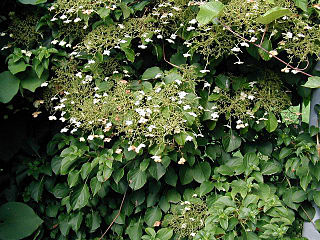
Hydrangea petiolaris, a climbing hydrangea, is a species of flowering plant in the family Hydrangeaceae native to the woodlands of Japan, the Korean peninsula, and on Sakhalin island of easternmost Siberia in the Russian Far East.

Hydrangea arborescens, commonly known as smooth hydrangea, wild hydrangea, sevenbark, or in some cases, sheep flower, is a species of flowering plant in the family Hydrangeaceae. It is a small- to medium-sized, multi-stemmed, deciduous shrub up to 2 m (7 ft) tall that is native to the eastern United States.

Hydrangea cinerea, the ashy hydrangea or gray hydrangea, is a small to medium sized, deciduous shrub up to 3 m tall; its natural range is interior regions of the southeastern United States. Its common names reflect the ashy or gray appearance of the undersides of its leaves, which results from a dense pubescence.

Physostegia virginiana, the obedient plant, obedience or false dragonhead, is a species of flowering plant in the mint family, Lamiaceae. It is native to North America, where it is distributed from eastern Canada to northern Mexico. Physostegia are known commonly as obedient plants because a flower pushed to one side will often stay in that position. The name “false dragonhead” refers to the dragonheads of the related Dracocephalum, a genus to which the plant once belonged.

Coleus scutellarioides, commonly known as coleus, is a species of flowering plant in the family Lamiaceae, native to southeast Asia through to Australia. Typically growing to 60–75 cm (24–30 in) tall and wide, it is a bushy, woody-based evergreen perennial, widely grown for the highly decorative variegated leaves found in cultivated varieties. Another common name is painted nettle, reflecting its relationship to deadnettles, which are in the same family. The synonyms Coleus blumei, Plectranthus scutellarioides and Solenostemon scutellarioides are also widely used for this species.
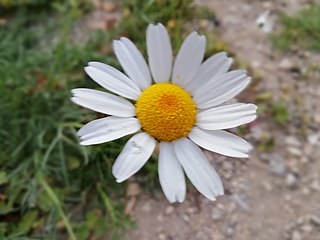
Argyranthemum frutescens, known as Paris daisy, marguerite or marguerite daisy, is a perennial plant known for its flowers. It is native to the Canary Islands. Hybrids derived from this species are widely cultivated as ornamental plants in private gardens and public parks in many countries, and have naturalized in Italy and southern California. There are many cultivars, but the most common has white petals.

Hydrangea serrata is a species of flowering plant in the family Hydrangeaceae, native to mountainous regions of Korea and Japan. Common names include mountain hydrangea and tea of heaven. Growing to 1.2 m (4 ft) tall and broad, it is a deciduous shrub with oval leaves and panicles of blue and pink flowers in summer and autumn (fall). It is widely cultivated as an attractive ornamental shrub throughout the world in areas with suitable climate and soil.

Hydrangea paniculata, or panicled hydrangea, is a species of flowering plant in the family Hydrangeaceae native to southern and eastern China, Korea, Japan and Russia (Sakhalin). It was first formally described by Philipp Franz von Siebold in 1829.

Hydrangea hirta, also known as the nettle-leaved hydrangea, is a species of flowering plant in the family Hydrangeaceae that is native to East Asia. Due to the beauty and sturdiness of the species' flowers it can be found outside of its range being used for horticultural and landscaping purposes, and is found in gardens in countries including the United Kingdom and the United States.

Hydrangea integrifolia is a species of flowering plant in the family Hydrangeaceae, native to Taiwan and the Philippines at elevations above 8,000 ft..

Hydrangea involucrata is a species of flowering plant in the family Hydrangeaceae, native to Japan and Taiwan. It is a deciduous shrub growing to 1 m (3 ft) tall by 2 m (7 ft) broad, with oval leaves and clusters of blue or pink flowers in late summer.
